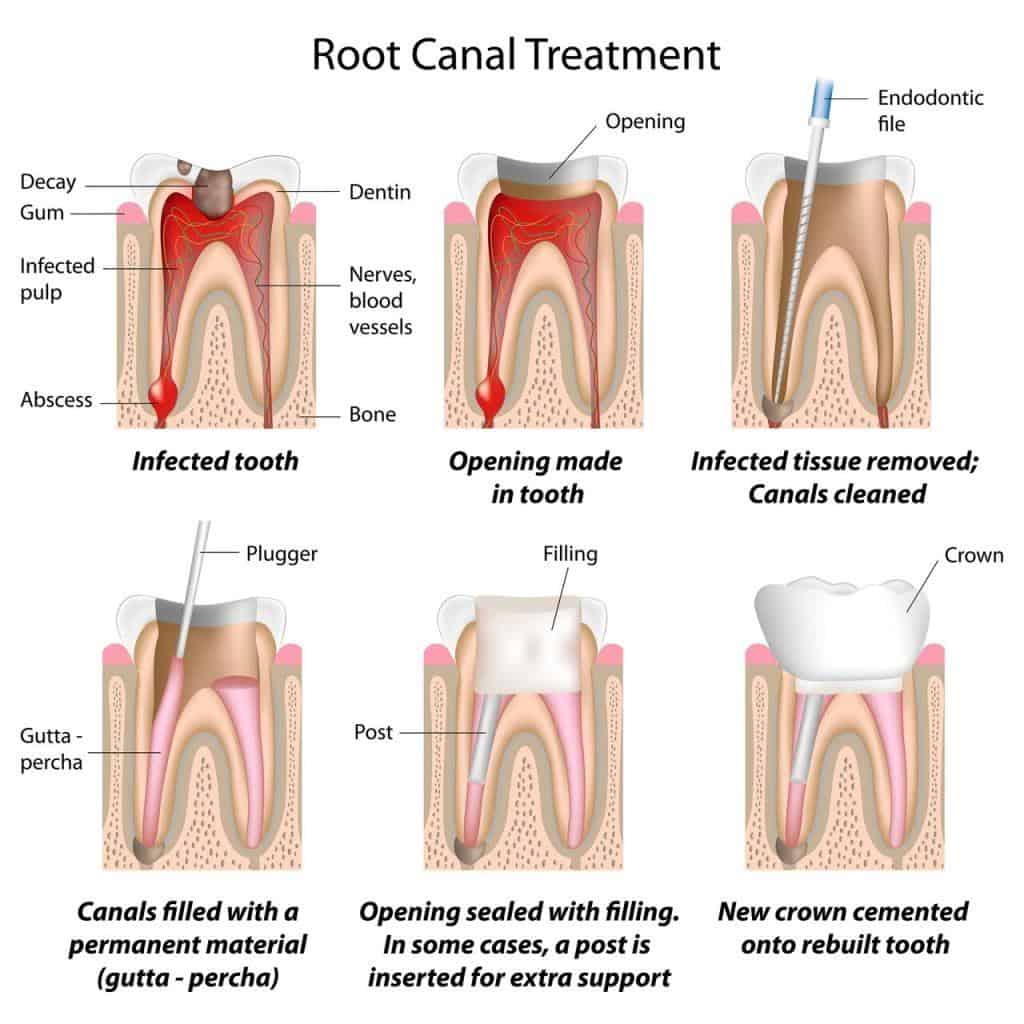
ROOT CANAL TREATMENT
What is a Root Canal Treatment?
Root canal or Endodontic treatment is performed to salvage a tooth that has become badly infected due to deep decay or severe damage caused by trauma; resulting in nerve death within the tooth. The procedure involves the removal of the infected or dead nerve (pulp) from within the tooth and cleaning and sealing the emptied root canal space to prevent bacterial growth.

When do I need a Root Canal Treatment?
Blood vessels and nerve tissue (the dental pulp) exists within each tooth, allowing your tooth to sense temperature, pressure and to fight off bacterial invasion. When a tooth’s nerve tissue gets injured (through a crack or trauma) or infected by bacteria (through a cavity), it becomes inflamed causing severe pain (toothache). Oral bacteria will then invade the pulp chamber and spread down into the roots. If left untreated, the infection can lead to the following:

- An abscess (pus-filled swelling) forming around the root of the tooth.
- Destruction of bone surrounding the root of the tooth. This may allow the abscess to burst through the weakened bone to drain pus into the mouth through the gums.
- Severe pain
Root canal treatment aims to stop this infectious process taking place within the root canal system and to eliminate pain. This will allow you to keep the tooth instead of extracting it.
After root canal treatment, the tooth becomes very brittle and weak. It may crack or fracture more easily when you chew on it. Protecting the biting surface with a crown or an onlay will help to prevent an irreparable fracture from occurring soon after root canal treatment is completed. This protection is mandatory for all root canal treated teeth that are subjected to high biting forces.
Root Canal Treatment at Elite Dental
Step 1: Consultation
During the first visit, we will examine your teeth carefully to identify the source of the toothache/infection.
Clinical tests and dental X-rays are taken to pinpoint the offending tooth. A 3D CBCT scan of the root canal space may be taken for complex cases involving multiple roots, and to look for hidden root curvatures, root resorption, and canal blockages among other issues that can complicate treatment.
The potential risks and complications involved as well as the long term prognosis for the tooth will then be discussed with you.
In some cases, it may be determined that your tooth is so badly damaged or infected that it may not survive for very long afterwards. In such cases, it may then be better to have the tooth removed and replaced with a dental implant, for example, for a higher chance of long term success.
Occasionally, you may be referred to a root canal specialist (endodontist) if your case has a high level of difficulty. We are proud to partner with experienced endodontists located close by, in the Orchard Road belt.
Here are some factors that would make root canal treatment difficult to perform :
- severely curved or twisted root canals
- blocked root canals
- root resorption
- cracks within the tooth or root
- previous root canal treatment
- presence of root canal posts and crowns
- patients with very limited mouth opening
- claustrophobic patients
Step 2: Root canal treatment procedure
 Before the procedure begins, your tooth will always be numbed with local anaesthetic.
Before the procedure begins, your tooth will always be numbed with local anaesthetic.
The tooth to be treated is then isolated with a perforated rubber sheet clamped on to the tooth (rubber dam). This is MANDATORY to ensure a clean, dry working field, to shield your throat and soft tissues from any disinfectant used and to prevent you from inhaling or swallowing tiny root canal instruments. Intra-Venous sedation or oral sedatives can be helpful to ensure an anxiety-free procedure, if you are very anxious or claustrophobic.
We will then gain access to the root canal system by drilling an opening into the tooth. Existing decay, old leaking fillings and defective crowns are usually removed as well. The root canals are then cleaned and shaped, flushed with disinfectant and sealed with a rubber sealant called gutta-percha. A filling is then placed to cover the access cavity and seal it off from any further bacteria ingress.

At the end, an x-ray is taken to double-check the root filling.
At Elite Dental, most root canal treatments are completed in a single visit. Occasionally, this may not be possible and a temporary antiseptic dressing is placed inside the tooth before you leave.
We will then prescribe you with painkillers and occasionally antibiotics to aid with the healing process.
Step 3: Preparing the root treated tooth for a dental crown
After root canal treatment, the remaining tooth structure becomes very brittle and can crack easily when chewed on. Covering the biting surface with a dental onlay or crown as soon as possible can prevent the tooth from breaking. We view crowning as mandatory and an essential part of finishing the treatment.
The tooth needs to be trimmed and shaped to accommodate the crown. A mould or digital scan of the prepared tooth is then made and transferred to the dental laboratory, where the crown is made. A temporary crown is then fitted to protect the tooth in the meantime.
Step 4: Fitting of the crown
Once the new crown is ready, the temporary crown is then removed. The fit, colour, shape and bite of your new crown will then be checked with your input, before it is finally cemented onto your tooth. After the crown has been fitted, your tooth still needs to be treated with care, since biting into very hard things like bones, ice, shellfish or opening bottles/cans with your teeth may damage the crown in the long run.
Does Root Canal Treatment Hurt?
Is root canal treatment painful?
Root canal treatment is not meant to be painful. It is a procedure that is done to relieve pain from sensitive, or teeth that is infected.
During a root canal treatment, you would have received local anaesthesia to desensitise and numb your teeth and gums. Because of the local anaesthesia, the root canal treatment is painless.
There are different ways to ensure that the root canal treatment has no pain. The use of additional anti-inflammatory drugs and sedation can be useful if you come in to the dental clinic with extreme pain.
What happens during root canal treatment?
After your tooth and the surrounding area has been numbed, your dentist will remove any existing filling material and decay. This is to decontaminate the tooth and create a favourable environment for healing.
Your dentist may repair part of the tooth with a filling to ensure a tight seal against bacteria in the future and to facilitate disinfection of the root canal space.
The tooth is usually isolated with a rubber dam to protect the throat and other parts of the mouth during the procedure.
The nerve is located by drilling into the tooth and examining it under a dental operating microscope. The microscope allows your dentist to visualize minute structures deep within the tooth and roots which may be smaller than the full stop on this page.
The root canals that contain the nerves of the tooth are cleaned out with mechanized instruments and disinfected. The root canals may be medicated for further disinfection and the tooth is sealed with a temporary filling for a few weeks. Medicating the canals is usually done for teeth that have abscesses, resorptive lesions or teeth with complex root canal anatomy (such as molars and premolars).
When the root canal treatment is to be completed, the canals are dried and filled with a natural rubber based filling called gutta percha. The access cavity is then filled with the final filling material.
Before, during and after the treatment, small x-rays are taken of the tooth that is being treated to evaluate different stages of root canal treatment.
How long does root canal treatment last?
Root canal treatment can remain successful for many years if the seal at the root tip and the seal around the crown of the tooth remains intact.
Teeth with a greater pre-treatment bacterial load (teeth with abscesses) are less likely to remain symptom free.
Cracked teeth may also fail because of crack progression introducing more bacteria into the root canal space.
Is it better to pull a tooth or get a root canal treatment?
Only a natural tooth maintains bone and gum tissue volume.
Once a tooth is extracted, the bone and gum shrink and it can be difficult to regenerate this.
Natural teeth are easier to maintain than artificial teeth like implants, bridges or dentures.
Only if a natural tooth is deemed to have a hopeless prognosis will extraction be recommended as a last resort.
Are you awake for a root canal treatment?
Most patients have their treatment under local anaesthesia only.
For patients who are more anxious, you can choose to have your treatment while sedated. There are different types of sedatives available, and your dentist will be able to advise on which is the most appropriate option based on your medical history and level of sedation required.
Do I need a dental crown after root canal treatment?
Back teeth usually need to be crowned after root canal treatment because they would have been weakened by the previous decay or crack that necessitated the root canal treatment in the first place.




